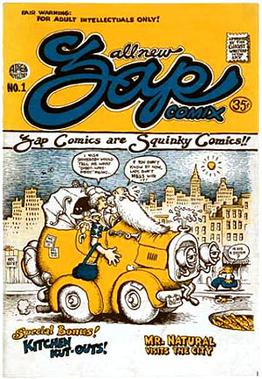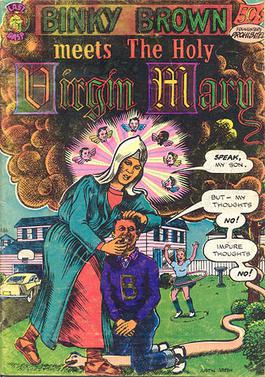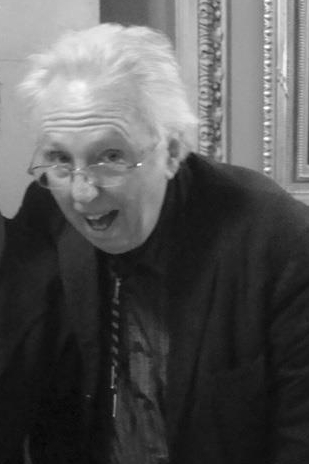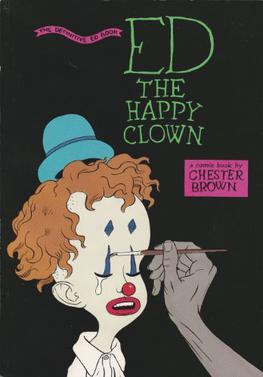
Underground comix are small press or self-published comic books that are often socially relevant or satirical in nature. They differ from mainstream comics in depicting content forbidden to mainstream publications by the Comics Code Authority, including explicit drug use, sexuality, and violence. They were most popular in the United States in the late 1960s and 1970s, and in the United Kingdom in the 1970s.

A graphic novel is a long-form, fictional work of sequential art. The term graphic novel is often applied broadly, including fiction, non-fiction, and anthologized work, though this practice is highly contested by comics scholars and industry professionals. It is, at least in the United States, typically distinct from the term comic book, which is generally used for comics periodicals and trade paperbacks.

Art Spiegelman is an American cartoonist, editor, and comics advocate best known for his graphic novel Maus. His work as co-editor on the comics magazines Arcade and Raw has been influential, and from 1992 he spent a decade as contributing artist for The New Yorker. He is married to designer and editor Françoise Mouly, and is the father of writer Nadja Spiegelman. In September 2022, the National Book Foundation announced that he would receive the Medal for Distinguished Contribution to American Letters.

Maus, often published with the subtitle A Survivor's Tale, is a graphic novel by American cartoonist Art Spiegelman, serialized from 1980 to 1991. It depicts Spiegelman interviewing his father about his experiences as a Polish Jew and Holocaust survivor. The work employs postmodern techniques, and represents Jews as mice and other Germans and Poles as cats and pigs. Critics have classified Maus as memoir, biography, history, fiction, autobiography, or a mix of genres. In 1992 it became the first graphic novel to win a Pulitzer Prize.
Justin Considine Green was an American cartoonist who is known as the "father of autobiographical comics." A key figure and pioneer in the 1970s generation of underground comics artists, he is best known for his 1972 comic book Binky Brown Meets the Holy Virgin Mary.

Binky Brown Meets the Holy Virgin Mary is an autobiographical comic by American cartoonist Justin Green, published in 1972. Green takes the persona of Binky Brown to tell of the "compulsive neurosis" with which he struggled in his youth and which he blamed on his strict Roman Catholic upbringing. Green was later diagnosed with obsessive–compulsive disorder (OCD) and came to see his problems in that light.

Raw was a comics anthology edited by Art Spiegelman and Françoise Mouly and published in the United States by Mouly from 1980 to 1991. It was a flagship publication of the 1980s alternative comics movement, serving as a more intellectual counterpoint to Robert Crumb's visceral Weirdo, which followed squarely in the underground tradition of Zap and Arcade. Along with the more genre-oriented Heavy Metal it was also one of the main venues for European comics in the United States in its day.

William Henry Jackson Griffith is an American cartoonist who signs his work Bill Griffith and Griffy. He is best known for his surreal daily comic strip Zippy. The catchphrase "Are we having fun yet?" is credited to Griffith.

Pantheon Books is an American book publishing imprint with editorial independence. It is part of the Knopf Doubleday Publishing Group.

Phoebe Louise Adams Gloeckner, is an American cartoonist, illustrator, painter, and novelist.

Françoise Mouly is a Paris-born New York-based designer, editor, and publisher. She is best known as co-founder, co-editor, and publisher of the comics and graphics magazine Raw (1980–1991), as the publisher of Raw Books and Toon Books, and since 1993 as the art editor of The New Yorker. Mouly is married to cartoonist Art Spiegelman, and is the mother of writer Nadja Spiegelman.

Ed the Happy Clown is a graphic novel by Canadian cartoonist Chester Brown. Its title character is a large-headed, childlike children's clown who undergoes one horrifying affliction after another. The story is a dark, humorous mix of genres and features scatological humour, sex, body horror, extreme graphic violence, and blasphemous religious imagery. Central to the plot are a man who cannot stop defecating; the head of a miniature, other-dimensional Ronald Reagan attached to the head of Ed's penis; and a female vampire who seeks revenge on her adulterous lover who had murdered her to escape his sins.
Robert Grossman was an American painter, sculptor, filmmaker, comics artist, illustrator and author.
Comics journalism is a form of journalism that covers news or nonfiction events using the framework of comics, a combination of words and drawn images. Typically, sources are actual people featured in each story, and word balloons are actual quotes. The term "comics journalism" was coined by one of its most notable practitioners, Joe Sacco. Other terms for the practice include "graphic journalism," "comic strip journalism", "cartoon journalism", "cartoon reporting", "comics reportage", "journalistic comics", and "sketchbook reports".

Dean Mullaney is an American editor, publisher, and designer whose Eclipse Enterprises, founded in 1977, was one of the earliest independent comic-book companies. Eclipse published some of the first graphic novels and was one of the first comics publishers to champion creators' rights. In the 2000s, he established the imprint The Library of American Comics of IDW Publishing to publish hardcover collections of comic strips. Mullaney and his work have received seven Eisner Awards.

The wordless novel is a narrative genre that uses sequences of captionless pictures to tell a story. As artists have often made such books using woodcut and other relief printing techniques, the terms woodcut novel or novel in woodcuts are also used. The genre flourished primarily in the 1920s and 1930s and was most popular in Germany.

Gods' Man is a wordless novel by American artist Lynd Ward (1905–1985) published in 1929. In 139 captionless woodblock prints, it tells the Faustian story of an artist who signs away his soul for a magic paintbrush. Gods' Man was the very first American wordless novel, and is considered a precursor of the graphic novel, whose development it influenced.

Mickey au Camp de Gurs is a 1942 French comic booklet by German-born French cartoonist of Jewish descent Horst Rosenthal. It was created while Rosenthal was a prisoner at the Gurs internment camp in France during World War II. The comic features Walt Disney's Mickey Mouse, who is arrested on suspicion of being Jewish and is sent to Gurs. Rosenthal acknowledged the source of his protagonist by adding "Publié Sans Autorisation de Walt Disney" to the front cover. Rosenthal was detained in Gurs for two years before being sent to Auschwitz in September 1942; he was executed on the day of his arrival.
Raw Books & Graphics is a publishing company specializing in comics and graphic novels. Operating since 1978, it is owned and operated by Françoise Mouly. The company first came to prominence publishing Raw magazine, co-edited by Mouly and her husband, cartoonist Art Spiegelman. In the 1980s the company published graphic novels, and with the formation of Raw Junior in 1999, branched into children's comics with Little Lit and Toon Books.















